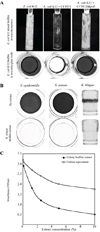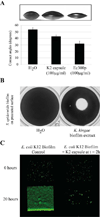Antibiofilm polysaccharides
- PMID: 22730907
- PMCID: PMC3502681
- DOI: 10.1111/j.1462-2920.2012.02810.x
Antibiofilm polysaccharides
Abstract
Bacterial extracellular polysaccharides have been shown to mediate many of the cell-to-cell and cell-to-surface interactions that are required for the formation, cohesion and stabilization of bacterial biofilms. However, recent studies have identified several bacterial polysaccharides that inhibit biofilm formation by a wide spectrum of bacteria and fungi both in vitro and in vivo. This review discusses the composition, modes of action and potential biological roles of antibiofilm polysaccharides recently identified in bacteria and eukarya. Some of these molecules may have technological applications as antibiofilm agents in industry and medicine.
© 2012 Society for Applied Microbiology and Blackwell Publishing Ltd.
Figures



Similar articles
-
Antibiofilm activity of Actinobacillus pleuropneumoniae serotype 5 capsular polysaccharide.PLoS One. 2013 May 14;8(5):e63844. doi: 10.1371/journal.pone.0063844. Print 2013. PLoS One. 2013. PMID: 23691104 Free PMC article.
-
Biofilms: an emergent form of bacterial life.Nat Rev Microbiol. 2016 Aug 11;14(9):563-75. doi: 10.1038/nrmicro.2016.94. Nat Rev Microbiol. 2016. PMID: 27510863 Review.
-
Bacterial capsular polysaccharides with antibiofilm activity share common biophysical and electrokinetic properties.Nat Commun. 2023 May 3;14(1):2553. doi: 10.1038/s41467-023-37925-8. Nat Commun. 2023. PMID: 37137893 Free PMC article.
-
Bacterial extracellular polysaccharides.Can J Microbiol. 1988 Apr;34(4):415-20. doi: 10.1139/m88-073. Can J Microbiol. 1988. PMID: 3052752 Review.
-
Environmental bacteria produce abundant and diverse antibiofilm compounds.J Appl Microbiol. 2014 Dec;117(6):1663-73. doi: 10.1111/jam.12639. Epub 2014 Sep 26. J Appl Microbiol. 2014. PMID: 25179003
Cited by
-
Analysis of Chemical Structure and Antibiofilm Properties of Exopolysaccharides from Lactiplantibacillus plantarum EIR/IF-1 Postbiotics.Microorganisms. 2022 Nov 7;10(11):2200. doi: 10.3390/microorganisms10112200. Microorganisms. 2022. PMID: 36363792 Free PMC article.
-
Antimicrobial and antibiofilm activity of biopolymer-Ni, Zn nanoparticle biocomposites synthesized using R. mucilaginosa UANL-001L exopolysaccharide as a capping agent.Int J Nanomedicine. 2019 Apr 10;14:2557-2571. doi: 10.2147/IJN.S196470. eCollection 2019. Int J Nanomedicine. 2019. PMID: 31118605 Free PMC article.
-
A new biofilm-associated colicin with increased efficiency against biofilm bacteria.ISME J. 2014 Jun;8(6):1275-88. doi: 10.1038/ismej.2013.238. Epub 2014 Jan 23. ISME J. 2014. PMID: 24451204 Free PMC article.
-
The role of biophysical parameters in the antilipopolysaccharide activities of antimicrobial peptides from marine fish.Mar Drugs. 2014 Mar 13;12(3):1471-94. doi: 10.3390/md12031471. Mar Drugs. 2014. PMID: 24633250 Free PMC article. Review.
-
Biogenic iron-silver nanoparticles inhibit bacterial biofilm formation due to Ag+ release as determined by a novel phycoerythrin-based assay.Appl Microbiol Biotechnol. 2020 Jul;104(14):6325-6336. doi: 10.1007/s00253-020-10686-w. Epub 2020 May 27. Appl Microbiol Biotechnol. 2020. PMID: 32462243
References
-
- Bakkiyaraj D, Pandian SK. In vitro and in vivo antibiofilm activity of a coral associated actinomycete against drug resistant Staphylococcus aureus biofilms. Biofouling. 2010;26:711–717. - PubMed
-
- Banat IM, Franzetti A, Gandolfi I, Bestetti G, Martinotti MG, Fracchia L, et al. Microbial biosurfactants production, applications and future potential. Appl Microbiol Biotechnol. 2010;87:427–444. - PubMed
-
- Bandara HM, Lam OL, Watt RM, Jin LJ, Samaranayake LP. Bacterial lipopolysaccharides variably modulate in vitro biofilm formation of Candida species. J Med Microbiol. 2010;59:1225–1234. - PubMed
-
- Bazaka K, Crawford RJ, Nazarenko EL, Ivanova EP. Bacterial extracellular polysaccharides. Adv Exp Med Biol. 2011;715:213–226. - PubMed
Publication types
MeSH terms
Substances
Grants and funding
LinkOut - more resources
Full Text Sources
Other Literature Sources

